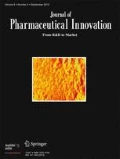Abstract
What is the role of standardized methods for determining the impact of material properties in pharmaceutical formulation and process development? In this Perspective article, we identify material properties that are potentially important in solid dosage form design, and we review approaches linking these properties to product specifications in dry granulation process development. We also assess the potential benefits that could be obtained by standardizing the methods for determining the impact of material properties of commonly used excipients and propose a program of research to achieve the desired goal of an efficient, science-based approach for incorporating material properties in solid dosage form design.
Similar content being viewed by others
References
Bolhuis, G.K. and Holzer, A.W. (1996) Lubricant sensitivity. InPharmaceutical Powder Compaction Technology (Alderborn, G. and Nistrom, C., eds), pp 517–560, Marcel Dekker.
Wurster, D.E.et al. (1999) Prediction of the Hiestand bonding indices of binary powder mixtures from single-component bonding indices.Pharm. Dev. Technol. 4, 65–70.
Fell, J.T. (1996) Compaction properties of binary mixtures. InPharmaceutical Powder Compaction Technology (Alderborn, G. and Nistrom, C., eds), pp 501–515, Marcel Dekker.
Prescott, J.K. and Barnum, R.A. (2000) On powder flowability.Pharm Technol 24, 60–84.
Sheskey, P.J. and Dasbach, T.P. (1995) Evaluation of various polymers as dry binders in the preparation of an immediate-release tablet formulation by roller compaction,Pharm Technol, October, 98–112.
Mollan, M.J. and Celik, M. (1996) The effects of lubrication on the compaction and post-compaction properties of directly compressible maltodextrins.Int. J. Pharm. 144, 1–9.
Inghelbrecht, S. and Remon, J.P. (1998) Roller compaction and tableting of microcrystalline cellulose/drug mixtures.Int. J. Pharm. 161, 215–224.
Mitchell, S.A.et al. (2003) A compaction process to enhance dissolution of poorly water-soluble drugs using hydroxypropyl methylcellulose.Int. J. Pharm. 250, 3–11.
Soares, L.A.L.et al. (2005) Dry granulation and compression of spraydried plant extracts.AAPS PharmSciTech 6, E359-E366.
Falzone, A.M.et al. (1992) Effects of changes in roller compactor parameters on granulations produced by compaction.Drug Dev. Ind. Pharm. 18, 469–489.
Hervieu, P.et al. (1994) Granulation of pharmaceutical powders by compaction — An experimental study.Drug Dev. Ind. Pharm. 20, 65–74.
Inghelbrecht, S. and Remon, J.P. (1998) The roller compaction of different types of lactose.Int. J. Pharm. 166, 135–144.
Inghelbrecht, S.et al. (1997) Instrumentation of a roll compactor and the evaluation of the parameter settings by neural networks.Int. J. Pharm. 148, 103–115.
Sheskey, P.et al. (2000), Roll compaction granulation of a controlled-release matrix tablet formulation containing HPMC — Effect of process scale-up on robustness of tablets, tablet stability, and predictedin vivo performance,Pharm Technol, November, 30–52.
Rambali, B.et al. (2001) Influence of the roll compactor parameter settings and the compression pressure on the buccal bio-adhesive tablet properties.Int. J. Pharm. 220, 129–140.
Simon, O. and Guigon, P. (2003) Correlation between powder-packing properties and roll press compact heterogeneity.Powder Technol 130, 257–164.
Johanson, J.R. (1965) A rolling theory for granular solids.J. Appl. Mech. 32, 842–848.
Jenike, A.W. and Shield, R.T. (1959) On the plastic flow of coulomb solids beyond original failure.J. Appl. Mech. 26, 599–602.
Bindhumadhavan, G.et al. (2005) Roll compaction of a pharmaceutical excipient: Experimental validation of rolling theory for granular solids.Chem. Eng. Sci. 60, 3891–3897.
Dec, R.T.et al. (2003) Comparison of various modeling methods for analysis of powder compaction in rolling press.Powder Technol 130, 265–271.
Sommer, K. and Hauser, G. (2003) Flow and compression properties of feed solids for roll-type presses and extrusion presses.Powder Technol 130, 272–276.
Cunningham, J.C.et al. (2004) Analysis of tablet compaction. I. Characterization of mechanical behavior of powder and powder/tooling friction.J. Pharm. Sci. 93, 2022–2039.
Lewis, R.W.et al. (2005) A combined finite-discrete element method for simulating pharmaceutical powder tableting.Int J Numer Meth Eng 62, 853–869.
Sanchez-Castillo, F.X.et al. (2003) Molecular dynamics simulations of granular compaction,Chemistry of Materials 15, 3417–3430.
Rowe, R.C.et al., eds (2003)Handbook of pharmaceutical excipients, 4th ed, American Pharmaceutical Association.
Thomson, G.H. and Larsen, A.H. (1996) DIPPR: Satisfying industry data needs.J. Chem. Eng. Data 41, 930–934.
Kline, A.A.et al. (1998) An overview of compiling, critically evaluating, and delivering reliable physical property data from AIChE DIPPR Projects 911 and 912.Fluid Phase Equilibr 150, 421–428.
Author information
Authors and Affiliations
Corresponding author
Rights and permissions
About this article
Cite this article
Hlinak, A.J., Kuriyan, K., Morris, K.R. et al. Understanding critical material properties for solid dosage form design. J Pharm Innov 1, 12–17 (2006). https://doi.org/10.1007/BF02784876
Issue Date:
DOI: https://doi.org/10.1007/BF02784876




